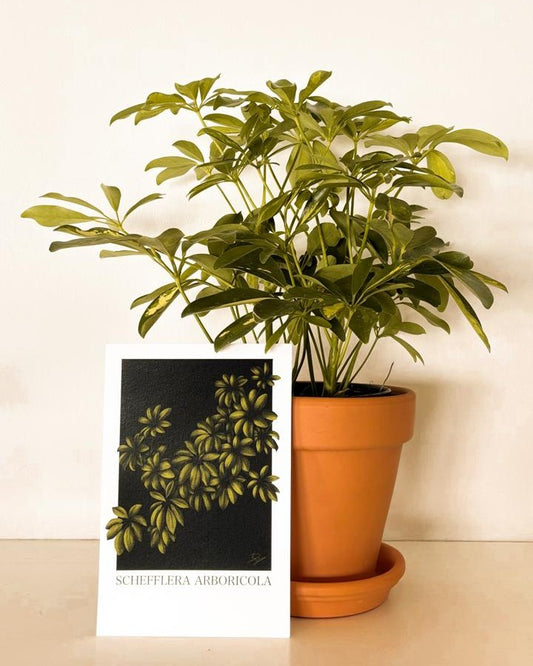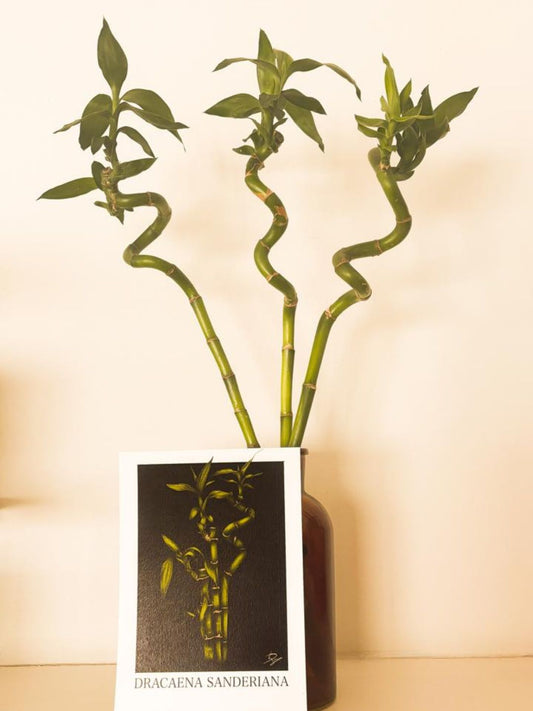Is the umbrella plant not the cutest looking plant you've ever seen? It almost looks fake! I've been keeping my eye out for this plant for months, and a few weeks ago I finally caved and bought a dwarf version. I placed it on our TV console table, and I simply adore it.
I keep thinking that this plant will make the perfect plant gift, because of, not only it's cuteness, but also it's ease of care. Here in South Africa we are in the middle of winter, and this plant hasn't complainted one bit. It just seems to be an all around happy plant, which are the best kind of plants in my opinion!
During this blog post we will be talking about all the fassets of the Umbrella plant including its origins, how to care for and propagate it, common problems, and as always (my favourite part): how to style it.

Botanical Name |
Schefflera 'Arboricola' |
Plant Family |
Araliaceae |
Common Name |
Umbrella plant/tree Australian schefflera |
Size |
Height: 1.2 to 2.4 meters Width: 0.9 to 1.2 meters |
Soil |
Well-draining soil that retains some moisture but does not become waterlogged. |
Mother Country |
Taiwan, China, Australia |
Toxicity |
Toxic to pets and humans |
Origin and History

The Schefflera is native to the tropical parts of Taiwan, China, and is also grown in Australia (hence its other common name: Australian schefflera). How interesting that that the "Umbrella" plant originated from a country known for its typhoons (Taiwan)?
I love how this plant has a quirky name to go with it's quirky look: Schefflera. This plant was named in honour of the Polish botanist Johann Peter Ernst von Scheffler. The more commonly used "Umbrealla plant" is, of course, due to the shape of it's leaf canopies that are arranged in the shape of an umbrella.
Identifying Features

The Umbrella plant is recognized by its glossy, oval-shaped leaves that cascade from a central stem, resembling the shape of an umbrella. The leaves are typically a very vibrant green, but variegated varieties with yellow or white patterns are also common. This plant can grow up to 2.5 metres tall given the perfect growing conditions.
Varieties and Cultivars

There are several varieties and cultivars of Schefflera 'Arboricola' that each have their own unique features. For instance, the 'Gold Capella' variety boasts green leaves with splashes of yellow, while the 'Trinette' cultivar is known for its creamy white and green variegation.
Care Requirements for the Umbrella Plant

Light Preferences
The umbrella plant loves bright, indirect light. It’s the perfect plant for a sunny window that’s not too sunny. While it can deal quite well in lower light conditions, it won’t show its full potential. Direct sunlight can actually burn its leaves, so keep it out of the harsh sun rays. A spot near a north or east-facing window works beautifully, and if you’re low on natural light, it’s quite adaptable to artificial lighting too.
Watering Schedule
Watering this plant is all about balance. Let the top 5-10cm of soil dry out before giving it a drink. Too much water can lead to root rot, which is a big no-no for your plant. During the growing season (spring and summer), it’ll need a bit more frequent watering, but come fall and winter, ease up a bit as its growth slows.
Soil and Potting
The umbrella plant is a fan of well-draining, airy soil. A mix of peat moss, perlite, and vermiculite will keep it happy by providing both moisture retention and excellent aeration. It’s a good idea to repot every 1-2 years or whenever it looks like it’s outgrowing its current pot. Go for a pot that’s just a tiny bit larger than its current one, and make sure it has drainage holes.
Temperature and Humidity
This plant is pretty relaxed when it comes to temperatures, preferring a range of 15-24°C. It can handle a brief dip to 10°C, but keep it away from frost and drastic temperature changes. Average indoor humidity is usually fine, but if your home or workplace is super dry, consider adding a humidity tray or using a room humidifier. It’ll thank you with lush, happy leaves.
Fertilizing Tips
Feed your umbrella plant with a balanced, water-soluble fertilizer every 4-6 weeks during the growing season. A regular houseplant fertilizer will do the trick. Cut back on feeding in the fall and winter when your umbrella plant is taking a break from growing. And remember, a little goes a long way! Over-fertilizing can lead to a buildup of salts in the soil, which is no good for the roots.
Pruning and Maintenance
Regular pruning keeps your umbrella plant looking its best. Trim off any dead or yellowing leaves to encourage fresh growth and keep pests and diseases at bay. For a bushier look, trim back any leggy stems. A gentle wipe with a damp cloth helps remove dust from the leaves, keeping them clean and happy.
Propagating the Umbrella Plant

Propagating your umbrella plant through stem cuttings is the most straightforward and effective method.
- Start by selecting a healthy, mature stem with at least a few leaves.
- Use a clean, sharp knife or scissors to cut a 10-15 cm piece just below a leaf node.
- Remove the lower leaves from the cutting to expose the node, which is where roots will develop.
- Place the cutting in a container with water or a pot filled with a moist, well-draining soil mix.
- If using water, change it every few days to keep it fresh.
- Roots should start forming in a few weeks. Once they’re a couple of centimeters long, transplant the cutting into a small pot with potting soil.
- Make sure to water your newly potted plant frequently during the first few weeks, as the roots are now used to water and will need time to adjust to a dry potting environment.
Styling Tips for the Umbrella Plant

Choosing the Right Pot
Because of how quirky and cute this plant is, finding a pot that doesn’t look great with it can be a challenge. Personally, I believe that opting for a simpler pot enhances the plant’s unique charm. A more understated pot allows the umbrella plant’s interestingly arranged leaves to stand out and become the focal point, showcasing its natural beauty without distraction.
Placement Ideas
Placement is crucial and sometimes challenging with the umbrella plant. Its bushy nature makes it a natural centerpiece. The dwarf version, in particular, works wonderfully as a focal point on dining or coffee tables. Larger, more fully grown plants, on the other hand, make striking focal points when placed on the floor or used as natural room dividers, adding a lush, tropical touch to any space.
Complementary Plants
Given their tree-like, upright growth, I like to pair umbrella plants with plants that offer a contrasting effect. For instance, a trailing Hoya carnosa or a cascading String of Turtles can complement the umbrella plant beautifully. The contrast between the upright, bushy umbrella plant and the flowing, cascading plants creates a dynamic and visually interesting display.
Troubleshooting Common Issues

Yellowing Leaves
Seeing yellow leaves on your umbrella plant? Don’t panic—this usually points to a couple of common issues. Overwatering is often the main culprit. If the soil stays too wet, it can lead to root rot, so let the top layer dry out between waterings and make sure your pot has good drainage.
Yellow leaves might also signal a lack of nutrients, especially if it’s been a while since your last feed. A balanced fertilizer could do the trick. Lastly, check for pests like spider mites or mealybugs, which can cause discoloration and need to be treated promptly.
Pests and Diseases
If you’re spotting tiny bugs or sticky residue on your umbrella plant, it might be dealing with pests like spider mites, mealybugs, or scale insects. Treat these critters with insecticidal soap or neem oil, and be sure to clean the affected areas thoroughly.
Fungal diseases can also be an issue, often due to too much moisture or poor air circulation. Improve airflow around your plant and avoid getting water on the leaves to keep fungal infections at bay.
Leaf Drop
It’s always a bit concerning when your plant starts shedding leaves, but don’t worry—leaf drop is often just a sign that your plant is under a bit of stress. Common causes include sudden temperature changes, drafts, or not enough light. Try to keep your plant in a stable spot, away from heaters and cold drafts. If you’ve been inconsistent with watering, getting back on track can help. Also, if you’ve recently moved the plant, give it a little time to adjust to its new spot.
Leggy Growth
If your umbrella plant is looking a bit lanky with long, sparse stems, it’s probably not getting enough light. Plants that get leggy are usually reaching out for more sunshine, so try moving it to a brighter location. A little pruning can also help; trimming back those long stems encourages the plant to grow fuller and bushier. And don’t forget to stick to good watering and feeding practices to support healthy growth.
Frequently Asked Questions (FAQs)

Can the Umbrella Plant Be Grown Outdoors?
The umbrella plant can be grown outdoors in regions with warm, tropical climates. If you’re in a cooler area, it’s best to keep it indoors. Even in warmer climates, it’s a good idea to provide some shade during the hottest part of the day to protect it from direct sunlight, which can scorch the leaves.
How Fast Does the Umbrella Plant Grow?
The growth rate of your umbrella plant can vary depending on the light, water, and overall care it receives. In ideal conditions, it can grow fairly quickly, adding several centimeters in height per year. However, growth may slow down during the winter months when the plant is not actively growing. Regular watering, proper lighting, and occasional feeding can help maintain a steady growth rate.
Is the Umbrella Plant Toxic to Pets?
Yes, all parts of the umbrella plant is toxic to pets. It contains calcium oxalate crystals, which can cause irritation and discomfort if ingested. Symptoms in pets may include drooling, vomiting, and difficulty swallowing. To keep your furry friends safe, place the plant in a location that’s out of their reach, or consider choosing pet-friendly plants if your pets like to nibble on greenery.
How Can I Make My Umbrella Plant Bushier?
To encourage a bushier growth habit in your umbrella plant, regular pruning is key. Trim back the longer, leggy stems to stimulate new growth and help the plant become fuller. You can also pinch off the tips of new growth to encourage branching. Providing sufficient light and maintaining a consistent watering and feeding routine will support healthy, dense foliage.
In conclusion, while the umbrella plant might not keep the rain away, it’s definitely sure to brighten your day! If you’ve made it this far, thank you so much for reading my blog post about this charming plant. If you have any questions that weren’t covered here, feel free to drop them in the comments below.
Happy planting! 😊




